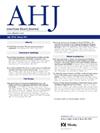Association between conversion from an initial shockable rhythm to pulseless electrical activity before extracorporeal cardiopulmonary resuscitation and outcome: A secondary analysis of the SAVE-J II study
IF 3.5
2区 医学
Q1 CARDIAC & CARDIOVASCULAR SYSTEMS
引用次数: 0
Abstract
Aim
Shockable rhythm on initial electrocardiogram is a predictor of favorable neurological outcomes of out-of-hospital cardiac arrest in patients undergoing extracorporeal cardiopulmonary resuscitation (ECPR). The present study evaluated the impact of conversion from shockable rhythm to pulseless electrical activity (PEA) before ECPR on patient outcomes.
Methods
In this secondary analysis of the data from SAVE-J II, a retrospective multicenter registry including 36 participating institutions in Japan, patients with initial shockable rhythm were categorized into those with conversion to PEA and sustained shockable rhythm. The primary outcome was favorable neurological outcome, defined as a cerebral performance category of 1-2 at hospital discharge.
Results
The final cohort included 718 patients. The rate of favorable neurological outcomes was lower in patients who were converted to PEA than in those with sustained shockable rhythm (12.9 % vs 26.4 %, P < .01). By multivariable analysis, conversion to PEA was significantly associated with a lower rate of favorable neurological outcomes (odds ratio 0.42, 95% confidence interval 0.27-0.66; P < .01). The rates of favorable neurologic outcomes were 9.8%, 18.0%, and 21.4% (P = .06) in patients who converted to PEA, during emergency medical services transport, at hospital arrival, and before ECMO initiation, respectively. However, outcomes did not significantly differ between the patients who converted to PEA after hospital arrival and those with sustained shockable rhythm (19.6% vs 26.4%, P = .19).
Conclusions
Patients with conversion to PEA before ECPR were associated with a lower rate of favorable neurological outcomes in those with an initial shockable rhythm. Especially, early conversion to PEA, ie, during EMS transport, may be a factor for lower favorable neurological outcomes compared to those with sustained shockable rhythm.
体外心肺复苏前从最初的休克节律到无脉电活动的转换与结果的关系——SAVE-JⅡ研究的二次分析
目的:体外心肺复苏(ECPR)患者院外心脏骤停后,初始心电图上的震荡节律是一个良好的神经预后预测指标。本研究评估了ECPR前从震荡节律到无脉电活动(PEA)的转换对患者预后的影响。方法:在对SAVE-J II数据的二次分析中,包括日本36个参与机构的回顾性多中心登记,将初始震荡性心律患者分为转换为PEA和持续震荡性心律患者。主要结局是良好的神经系统结局,定义为出院时大脑表现1-2。结果:最终队列包括718例患者。转换为PEA的患者的神经系统预后良好率低于持续震荡心律患者(12.9% vs 26.4%, P < 0.01)。通过多变量分析,转换为PEA与较低的神经系统预后良好率显著相关(优势比0.42,95%可信区间0.27-0.66;P < 0.01)。在转换为PEA的患者中,在紧急医疗服务转运期间,在医院到达时和在ECMO开始前,神经系统预后良好的比例分别为9.8%,18.0%和21.4% (P = 0.06)。然而,到达医院后转换为PEA的患者和持续震荡性心律的患者之间的结果没有显著差异(19.6% vs 26.4%, P = 0.19)。结论:在ECPR前转换为PEA的患者与初始震荡节律患者的良好神经预后率较低相关。特别是,早期转换为PEA,即在EMS运输过程中,可能是与持续震荡节律相比较低的神经系统预后的一个因素。
本文章由计算机程序翻译,如有差异,请以英文原文为准。
求助全文
约1分钟内获得全文
求助全文
来源期刊

American heart journal
医学-心血管系统
CiteScore
8.20
自引率
2.10%
发文量
214
审稿时长
38 days
期刊介绍:
The American Heart Journal will consider for publication suitable articles on topics pertaining to the broad discipline of cardiovascular disease. Our goal is to provide the reader primary investigation, scholarly review, and opinion concerning the practice of cardiovascular medicine. We especially encourage submission of 3 types of reports that are not frequently seen in cardiovascular journals: negative clinical studies, reports on study designs, and studies involving the organization of medical care. The Journal does not accept individual case reports or original articles involving bench laboratory or animal research.
 求助内容:
求助内容: 应助结果提醒方式:
应助结果提醒方式:


